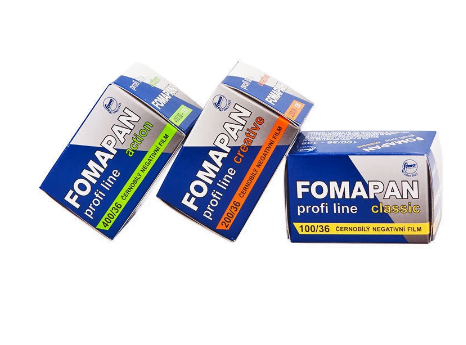In the vast world of black and white photography, choosing the right film stock can significantly impact the final outcome of your work. Among the variety of options available, Fomapan film stocks have established a niche with their distinctive characteristics and affordability. This post explores the three main offerings from Fomapan – the 100, 200, and 400 ISO film stocks, and unveils the winner in my book: Fomapan 400.

Starting off with the lowest ISO in the range, Fomapan 100 is known for its fine grain and high resolution. It’s a film that performs excellently in well-lit conditions or controlled lighting scenarios. The gentle contrast and smooth tonal transitions it renders make it a great choice for portrait photography or any situation where subtlety is key. However, its low ISO can be a limitation in less than ideal lighting conditions.
On the other end of the spectrum is Fomapan 400, a high-speed film that is versatile across a range of lighting situations. The first thing that catches the eye with Fomapan 400 is its high contrast. The blacks are deep, and the whites are bright, creating images with a dramatic and bold aesthetic. The grain structure is more pronounced than its lower ISO counterparts, yet it presents a pleasing aesthetic that adds a gritty, tactile quality to the images. This film is particularly useful in low-light conditions or fast-moving scenarios, thanks to its higher ISO. The versatility of Fomapan 400 makes it a reliable choice for a variety of photographic endeavors, from street photography to capturing indoor events.
Nestled in the middle is Fomapan 200, attempting to strike a balance between the fine-grain performance of Fomapan 100 and the high-speed versatility of Fomapan 400. However, it’s here where Fomapan 200 finds its struggle. The film has a tendency to perform best when overexposed, which effectively negates the advantage of its 200 ISO rating. When shot at box speed, the film can exhibit a lack of shadow detail, and the mid-tones aren’t as well defined. This characteristic makes it harder to recommend, especially when Fomapan 100 offers a more reliable performance with finer grain, and Fomapan 400 provides a high-speed alternative for varying lighting conditions.
A notable mention is the difference in the base material between the 35mm and 120 formats across all Fomapan stocks. The 35mm versions come with a thicker triacetate base, which I found to be preferable over the thin polyester base of the 120 stocks. The 120 films also have an added anti-halation layer, which while useful in reducing halos around bright light sources, requires a pre-rinse before development to remove. The thicker base of the 35mm films provides a level of handling robustness that is lacking in the 120 format, making the 35mm versions a more user-friendly choice for everyday shooting.
After spending considerable time with all three Fomapan film stocks, Fomapan 400 emerges as my top choice. The high contrast, pleasing grain structure, and higher ISO make it a versatile choice in multiple scenarios. It’s a film that delivers a distinctive look right out of the box, reducing the need for post-processing to achieve a desired contrasty look.
Following closely is Fomapan 100, with its fine grain and smooth tonal rendering making it a worthy choice for controlled lighting conditions or well-lit outdoor scenarios. However, the limitation in ISO can be a drawback for those shooting in less than ideal lighting conditions.
Fomapan 200, despite its middle-ground ISO, finds itself harder to recommend due to its requirement for overexposure to achieve optimal results. This characteristic, coupled with its less defined grain and tonal rendition when compared to Fomapan 100, places it last on my list.
In conclusion, while each Fomapan film stock has its place, Fomapan 400 stands out as the most versatile and aesthetically pleasing option among the three. Its ability to perform reliably across a range of lighting conditions, coupled with a high contrast and pleasing grain structure, makes it a go-to choice for capturing the myriad shades of life in black and white.